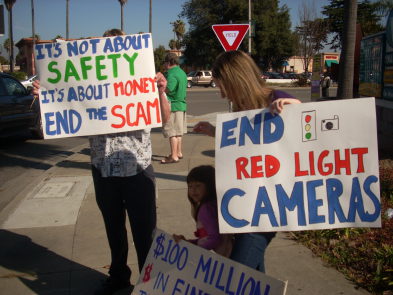 Since Florida began to use red-light cameras in 2007, many arguments have been made against them from violation of privacy rights to whether they operate correctly. Yet, in 2010,Florida passed a law which authorized the use of the cameras to issue traffic tickets. In November, the Florida Supreme Court heard a case challenging Florida traffic tickets issued as a result of evidence caught by red-light cameras. The Supreme Court is hearing the case because two lower courts disagreed on whether a city had the right to begin red-light camera enforcement prior to the state legislature’s passing of the law in 2010. One city,Orlando, lost its appeal to keep $4.3 million in fines it had collected, while another city, Aventura, won its appeal to keep the money it had collected. The Supreme Court must now decide between the two positions on the issue of a red-light ticket in Florida, including if you got a ticket in Broward County.
Since Florida began to use red-light cameras in 2007, many arguments have been made against them from violation of privacy rights to whether they operate correctly. Yet, in 2010,Florida passed a law which authorized the use of the cameras to issue traffic tickets. In November, the Florida Supreme Court heard a case challenging Florida traffic tickets issued as a result of evidence caught by red-light cameras. The Supreme Court is hearing the case because two lower courts disagreed on whether a city had the right to begin red-light camera enforcement prior to the state legislature’s passing of the law in 2010. One city,Orlando, lost its appeal to keep $4.3 million in fines it had collected, while another city, Aventura, won its appeal to keep the money it had collected. The Supreme Court must now decide between the two positions on the issue of a red-light ticket in Florida, including if you got a ticket in Broward County.
Several issues have been raised by special interest groups, individual citizens and the media about the use of the cameras. One of the most common has been whether the cameras increase public safety by discouraging drivers from running late cautions, turning on red without stopping and other safety issues, or whether the cameras are just a way for cities to raise money, basically by using an “automated” ticketing system for a red light ticket in Florida. One recent study shows that accidents actually increased in one city and place the increase firmly on the incorrect timing of the yellow caution signal. According to the study, shortening the time of the yellow light is one technique used to generate more red-light citations and, thus, more revenue. But the study also notes that shortening the caution signal is misleading to drivers who think they have time to pass through the intersection or make a turn, and these driver miscalculations are what are causing the accident rate to increase.
In Florida, the 2010 law that governs the red-light cameras, called the “Mark Wandall Traffic Safety Act,” requires that cities and counties that issue a red-light ticket in Florida submit data on an annual basis to the state’s Department of Highway Safety & Motor Vehicles (DHSMV). Among the facts to be reported are answers to questions such as whether accidents at those intersections have increased or decreased and, even more specifically, whether side or rear-end collisions have increased or decreased. But close to half of the cities and counties using the cameras failed to answer these questions.
One reason could be that while more than $100 million in fines based on red-light camera evidence were issued in Florida last year, one study in the Tampa area shows that, while the number of violations are decreasing, the number of accidents are not. While the city of Tampa touted a 29% decrease in accidents at intersections with a camera, the data collected by the Tampa Police Department shows only an 11% decrease. Another study points out that, while side-impact collisions may decrease because of the deterrent of running a red light, rear-end crashes may increase when drivers slam on brakes to stop and avoid the ticket.
If you receive a red-light ticket in Florida based upon camera evidence, there are numerous defenses for fighting the fine. From unintentional malfunctioning of the equipment to an actual manipulation of the equipment to shorten caution lights, making it more likely for you to run a red light, all the issues should be examined if you believe that you were wrongly cited. With the case pending before the Supreme Court, some of these issues may be resolved. But in the meantime, if you receive a red-light ticket in Florida, consult an attorney with knowledge of the many defenses to these alleged violations.

FREE CONSULTATION
866-433-3363
Call now or contact us for a fast, free, no obligation consultation.

